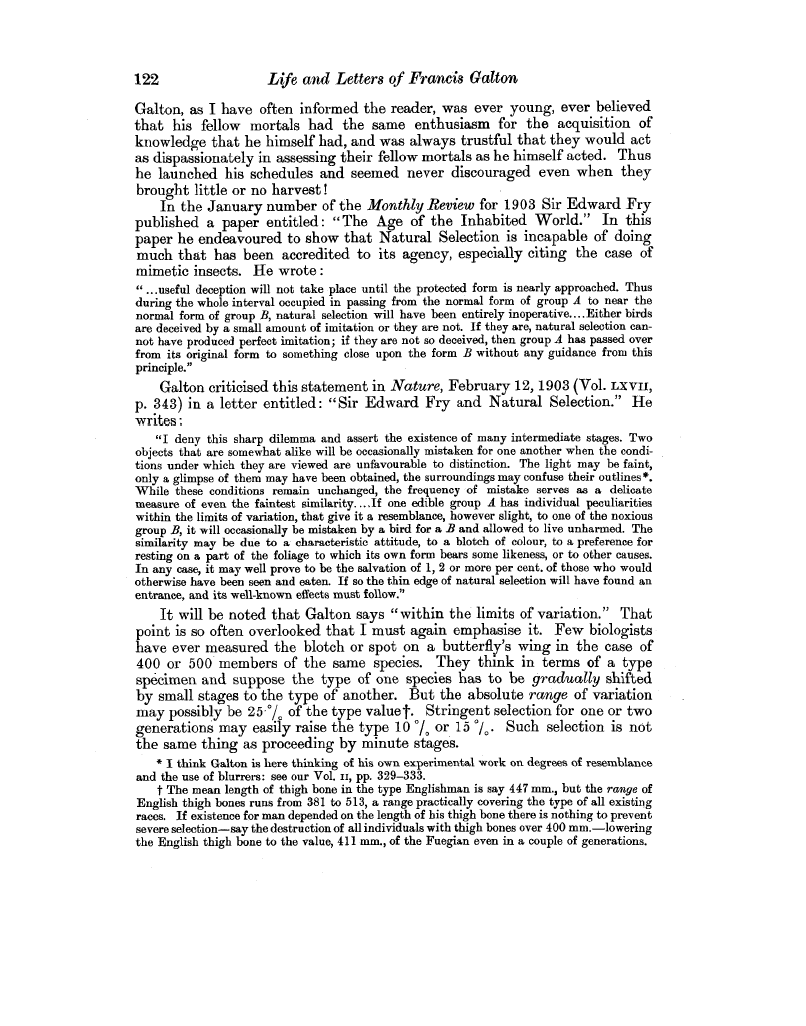| ||||||

OCR Rendition - approximate
122 Life and Letters of Francis Galton Galton, as I have often informed the reader, was ever young, ever believed that his fellow mortals had the same enthusiasm for the acquisition of knowledge that he himself had, and was always trustful that they would act as dispassionately in assessing their fellow mortals as he himself acted. Thus he launched his schedules and seemed never discouraged even when they brought little or no harvest ! In the January number of the Monthly Review for 1903 Sir Edward Fry published a paper entitled: "The Age of the Inhabited World." In this paper he endeavoured to show that Natural Selection is incapable of doing much that has been accredited to its agency, especially citing the case of mimetic insects. He wrote " ...useful deception will not take place until the protected form is nearly approached. Thus during the whole interval occupied in passing from the normal form of group A to near the normal form of group B, natural selection will have been entirely inoperative .... Either birds are deceived by a small amount of imitation or they are not. If they are, natural selection cannot have produced perfect imitation; if they are not so deceived, then group A has passed over from its original form to something close upon the form B without any guidance from this principle." Galton criticised this statement in Nature, February 12, 1903 (Vol. LXVII, p. 343) in a letter entitled: "Sir Edward Fry and Natural Selection." He writes "I deny this sharp dilemma and assert the existence of many intermediate stages. Two objects that are somewhat alike will be occasionally mistaken for one another when the conditions under which they are viewed are unfavourable to distinction. The light may be faint, only a glimpse of them may have been obtained, the surroundings may confuse their outlines*. While these conditions remain unchanged, the frequency of mistake serves as a delicate measure of even the faintest similarity. _If one edible group A has individual peculiarities within the limits of variation, that give it a resemblance, however slight, to one of the noxious group B, it will occasionally be mistaken by a bird for a B and allowed to live unharmed. The similarity may be due to a characteristic attitude, to a blotch of colour, to a preference for resting on a part of the foliage to which its own form bears some likeness, or to other causes. In any case, it may well prove to be the salvation of 1, 2 or more per cent. of those who would otherwise have been seen and eaten. If so the thin edge of natural selection will have found an entrance, and its well-known effects must follow." It will be noted that Galton says "within the limits of variation." That point is so often overlooked that I must again emphasise it. Few biologists have ever measured the blotch or spot on a butterfly's wing in the case of 400 or 500 members of the same species. They think in terms of a type specimen and suppose the type of one species has to be gradually shifted by small stages to the type of another. But the absolute range of variation may possibly be 25°°/. of the type value t. Stringent selection for one or two generations may easily raise the type 10 °/o or 15 "/.. Such selection is not the same thing as proceeding by minute stages. * I think Galton is here thinking of his own experimental work on degrees of resemblance and the use of blurrers: see our Vol. ix, pp. 329-333. t The mean length of thigh bone in the type Englishman is say 447 mm., but the range of English thigh bones runs from 381 to 513, a range practically covering the type of all existing races. If existence for man depended on the length of his thigh bone there is nothing to prevent severe selection-say the destruction of all individuals with thigh bones over 400 mm.-lowering the English thigh bone to the value, 411 mm., of the Fuegian even in a couple of generations.
|